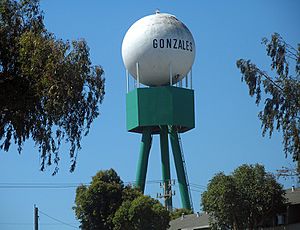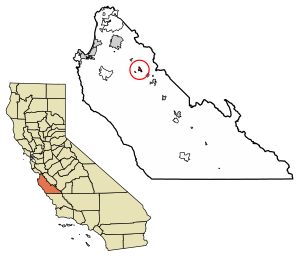Gonzales, California facts for kids
Quick facts for kids
Gonzales, California
|
|
|---|---|
| City of Gonzales | |

Gonzales water tower
|
|

Location in Monterey County, California
|
|
| Country | United States |
| State | California |
| County | Monterey |
| Incorporated | January 14, 1947 |
| Area | |
| • Total | 1.95 sq mi (5.1 km2) |
| • Land | 1.91 sq mi (4.9 km2) |
| • Water | 0.04 sq mi (0.1 km2) 1.95% |
| Elevation | 135 ft (41 m) |
| Population
(2020)
|
|
| • Total | 8,647 |
| • Density | 4,527.2/sq mi (1,748.0/km2) |
| Time zone | UTC-8 (Pacific) |
| • Summer (DST) | UTC-7 (PDT) |
| ZIP code |
93926
|
| Area code | 831 |
| FIPS code | 06-30392 |
| GNIS feature ID | 1659726 |
Gonzales is a city in Monterey County, California, United States. It is located about 16 miles southeast of Salinas. The city sits at an elevation of 135 feet (41 meters). In 2020, Gonzales had a population of 8,647 people. This was an increase from 8,187 people in 2010.
Gonzales is part of the Association of Monterey Bay Area Governments. In 2019, the city won the Culture of Health Prize from the Robert Wood Johnson Foundation.
Contents
History of Gonzales
Gonzales was founded by Dr. Mariano Gonzalez and his brother Alfredo Gonzales. They built the town on land that was once part of a large ranch called Rancho Rincon de la Puente del Monte. This ranch was given to their father, Teodoro Gonzalez, in 1836. At that time, their father was serving as the alcalde (a type of mayor or judge) of Monterey.
Early Development
In 1874, the Gonzalez brothers planned the town. They laid out 50 blocks on about 15,000 acres of land. The streets were set up in a grid pattern. In 1872, they gave land to the Southern Pacific Railroad. The railroad then built a station for both goods and passengers. At this time, the main businesses were growing grain and raising cattle.
The Gonzalez brothers also created one of the first irrigation systems in the Salinas Valley. They built a dam on the nearby Salinas River. They also dug many miles of canals to bring water to the farms.
Swiss Dairy Community
In the early 1900s, Gonzales became a center for Swiss dairy farming. This happened when John B. Meyenberg brought his special milk processing methods to the area. His company, Alpine Milk Company, opened its first factory in Gonzales in 1906. This company later became known as the Meyenberg Milk Products Company. At one point, there were 7,000 cows being milked within five miles of the town!
Gonzales had a few nicknames over the years. It was called "Little Switzerland" because the valley looked like Switzerland and many Swiss people lived there. Later, it was known as "The Heart of the Salad Bowl" because of its central spot in the farming valley. Today, it is often called the "Wine Capital of Monterey County."
Changes in Farming
Dairy farming slowly changed to growing fruits and vegetables in the 1920s. This was successful because of the rich soil and new ways of farming. Better irrigation, new machines, and improved transportation helped the Salinas Valley become a top farming area in the nation. Now, only one dairy farm is left near Gonzales.
First Buildings
The first school house in Gonzales was built in 1874. The first church, the Gonzales Baptist Church, was built in 1884. It still holds services every week. St. Theodore Catholic Church, named after Teodoro Gonzales, was built in 1883. The town officially became a city on January 10, 1947.
Geography and Location
Gonzales is located in the northern part of Monterey County, California. It is in the Salinas Valley. U.S. Route 101 runs along the northeast side of the city. You can get to the highway from three different exits. US 101 goes northwest 17 miles to Salinas, which is the main city of the county. It also goes southeast 8 miles to Soledad.
The United States Census Bureau says that Gonzales covers a total area of 1.95 square miles (5.05 square kilometers). Only a small part, about 0.04 square miles (0.10 square kilometers), is water.
Population Information
| Historical population | |||
|---|---|---|---|
| Census | Pop. | %± | |
| 1880 | 233 | — | |
| 1890 | 359 | 54.1% | |
| 1950 | 1,821 | — | |
| 1960 | 2,138 | 17.4% | |
| 1970 | 2,575 | 20.4% | |
| 1980 | 2,891 | 12.3% | |
| 1990 | 4,660 | 61.2% | |
| 2000 | 7,525 | 61.5% | |
| 2010 | 8,187 | 8.8% | |
| 2020 | 8,647 | 5.6% | |
| U.S. Decennial Census | |||
Gonzales has grown quite a bit over the years. In 1880, there were only 233 people living there. By 2020, the population had grown to 8,647.
Local Media
Gonzales has local radio stations like KHIP-FM - 104.3 and KKMC-AM - 880. Television service for the area comes from the Monterey-Salinas-Santa Cruz region. Local newspapers include the Salinas Californian, the Monterey County Herald, and the Gonzales Tribune. The Gonzales Tribune was first published in 1890. At one time, it was the newspaper with the most readers in Monterey County.
Wine-Growing Area
Gonzales is an important area for growing grapes and making wine. Many wineries are located here. Some of these include Constellation Brands, Robert Talbott, Pisoni Vineyards, Boekenoogen Winery, McIntyre Vineyards, Mer Soleil, and Salinas Valley Vineyards.
Academics at Gonzales High School
Gonzales High School offers many different classes. These include classes in fine arts, agriculture, and technology. The school also has special programs for students who want to earn college credits early. These programs are for subjects like language arts, math, social studies, and science. All the courses offered at Gonzales High School are approved by the California State University (CSU) and University of California (UC) systems.
Gonzales Water Tower
The water tower in Gonzales is a unique sight. It has a white, golf ball-shaped tank. This tank is held up by three green, tube-like legs. The water tower stands about 125 feet (38 meters) high.
Climate in Gonzales
Gonzales has a climate known as a hot-summer mediterranean climate. This means it has dry summers with very hot days and cool nights. The winters are moderately humid with mild to cool days and nights that can get below freezing. The average monthly temperature never goes above 71.6°F (22°C). Summer daytime temperatures usually average around 35°C (95°F). However, nights are cool to cold all year round.
| Climate data for Gonzales | |||||||||||||
|---|---|---|---|---|---|---|---|---|---|---|---|---|---|
| Month | Jan | Feb | Mar | Apr | May | Jun | Jul | Aug | Sep | Oct | Nov | Dec | Year |
| Record high °F (°C) | 86 (30) |
86 (30) |
93.0 (33.9) |
100.0 (37.8) |
106.0 (41.1) |
111.9 (44.4) |
116.1 (46.7) |
115.0 (46.1) |
114.1 (45.6) |
116.1 (46.7) |
93.9 (34.4) |
90.0 (32.2) |
116.1 (46.7) |
| Mean daily maximum °F (°C) | 61 (16) |
63.0 (17.2) |
66.0 (18.9) |
71.8 (22.1) |
79.7 (26.5) |
88 (31) |
95.5 (35.3) |
94.8 (34.9) |
90.7 (32.6) |
81.0 (27.2) |
69.4 (20.8) |
61.9 (16.6) |
76.9 (24.9) |
| Daily mean °F (°C) | 46.8 (8.2) |
49.1 (9.5) |
51.4 (10.8) |
55.2 (12.9) |
61.2 (16.2) |
67.3 (19.6) |
72.9 (22.7) |
72.3 (22.4) |
69.4 (20.8) |
61.9 (16.6) |
53.2 (11.8) |
47.7 (8.7) |
59.0 (15.0) |
| Mean daily minimum °F (°C) | 32.7 (0.4) |
35.2 (1.8) |
36.7 (2.6) |
38.8 (3.8) |
43 (6) |
46.6 (8.1) |
50.4 (10.2) |
49.8 (9.9) |
48.4 (9.1) |
43 (6) |
37.0 (2.8) |
33.4 (0.8) |
41.2 (5.1) |
| Record low °F (°C) | 10.0 (−12.2) |
17.1 (−8.3) |
18.0 (−7.8) |
21.0 (−6.1) |
26.1 (−3.3) |
28.0 (−2.2) |
35.1 (1.7) |
30.9 (−0.6) |
32.0 (0.0) |
25.0 (−3.9) |
15.1 (−9.4) |
10.0 (−12.2) |
10.0 (−12.2) |
| Average precipitation inches (mm) | 3.3 (83) |
3.1 (79) |
2.9 (73) |
1.3 (32) |
0.4 (11) |
0.1 (2) |
0.0 (1) |
0.0 (1) |
0.2 (5) |
0.7 (19) |
1.7 (42) |
2.8 (72) |
16.5 (420) |
| Average precipitation days | 9 | 9 | 9 | 5 | 2 | 1 | 0 | 0 | 1 | 3 | 6 | 9 | 54 |
Economy and Jobs
The economy of Gonzales is supported by several businesses. Here are some of the largest employers in the city:
| # | Employer | # of Employees |
|---|---|---|
| 1 | Taylor Farms | 600 |
| 2 | Gonzales Unified School District | 283 |
| 3 | Growers Express | 200 |
| 4 | Jackpot Harvesting | 187 |
| 5 | Constellation Brands | 100 |
| 6 | Silva Farms | 100 |
| 7 | Green Valley Farm Supply | 75 |
| 8 | Gonzales Packing Company | 66 |
| 9 | Ramsay Highlander | 55 |
Notable People from Gonzales
- John Blume: He is known as the "Father of Earthquake Engineering" and was born in Gonzales.
- Honoré Escolle: This French businessman bought a large ranch near Gonzales.
Schools in Gonzales
The Gonzales Unified School District serves the city. Here are the schools in the district:
- La Gloria Elementary (Kindergarten to 5th grade)
- Fairview Middle School (6th to 8th grade)
- Gonzales High School (9th to 12th grade)
- Somavia Continuation School
See also
 In Spanish: Gonzales (California) para niños
In Spanish: Gonzales (California) para niños


